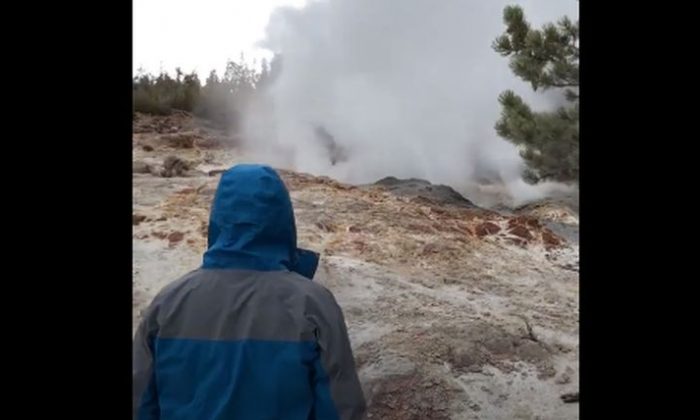The U.S. Geological Survey’s Yellowstone Volcano Observatory said the Steamboat geyser produced 32 eruptions in 2018.
This, according to the agency, breaks the record of 29 set in 1964.
The Steamboat geyser, which is the tallest active geyser on Earth, became more active in May 2018, and “entered a phase of more frequent water eruptions, much like it did in the 1960s and early 1980s,” according to the agency.
The agency added: “Although these eruptions do not have any implications for future volcanic activity at Yellowstone—after all, geysers are supposed to erupt, and most are erratic, like Steamboat—they are nonetheless spectacular,” Newsweek reported.

Jamie Farrell, with the Department of Geology and Geophysics at the University of Utah, said the activity goes through periods of ups and downs.
“Hydrothermal systems are very dynamic, and things change all the time,” he was quoted as saying. “This isn’t the first time Steamboat has a period of high eruption activity. That doesn’t mean something isn’t driving it. I’m sure there is a reason for this increased activity, but I’m not sure anyone really knows what that is at the moment.”
The Steamboat geyser’s major eruptions can hit more than 300 feet in height, says the National Park Service
“Curtains of water fall to the slope above the geyser and collect in torrents rushing back into the vents, carrying huge amounts of mud, sand, and rock that are shot skyward again and again. Water coats everything with a glistening layer of silica. A significant amount of eruption debris can accumulate around the geyser. Even cars in the parking area can be littered with debris,” the agency says.
Yellowstone is home to dozens of geysers, with more than anywhere else in the world.
In 2018, Yellowstone’s Ear Spring erupted for the first time since 1957, effectively vomiting out decades of trash that had been thrown inside.
“Changes in Yellowstone’s hydrothermal features are common occurrences and do not reflect changes in activity of the Yellowstone volcano,” said the USGS at the time.
“Shifts in hydrothermal systems occur only in the upper few hundred feet of the Earth’s crust and are not directly related to movement of magma several kilometers deep. There are no signs of impending volcanic activity.”
February Update
Meanwhile, the Volcano Observatory gave a monthly update after the government shutdown on the Yellowstone volcano, saying the Steamboat geyser “remains active” and noted an earthquake swarm in late January.
The University of Utah Seismograph Stations, which monitors Yellowstone’s seismic activity, said there were 84 earthquakes in January, adding the “largest event was a minor earthquake of magnitude 3.0 located 5 miles south-southwest of West Thumb (in Yellowstone National Park) on January 23 at 03:05 AM MST,” according to the Observatory o Feb. 1.
After Ear Spring erupted on September 15, employees found a strange assortment of items strewn across the landscape…
But it noted there was an earthquake swarm of about 12 quakes between Jan. 22 and Jan. 23, ranging in size from 0.1 to 1.3 on the Richter scale, the Yellowstone Volcano Observatory said, adding that such swarms account for about half the total seismic activity in the Yellowstone park.
“Yellowstone earthquake activity remains at background levels,” the agency added.
Meanwhile, there was no significant change in the surface deformation in the Yellowstone area.
“Ground subsidence of Yellowstone caldera continues, as it has since 2015, at a rate of a few millimeters per month. In the area of Norris Geyser Basin, GPS data indicate no vertical deformation,” said the report.
From The Epoch Times

